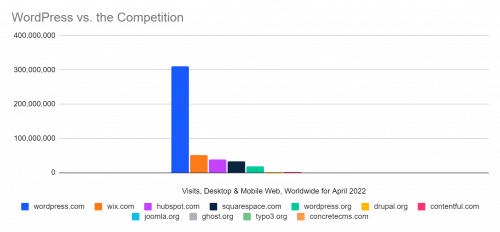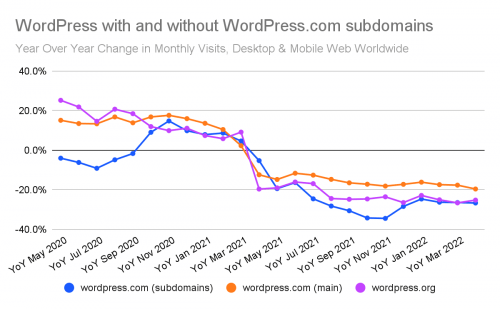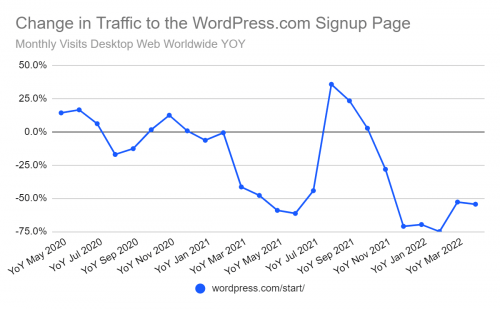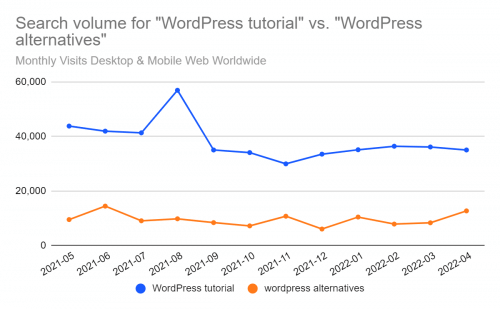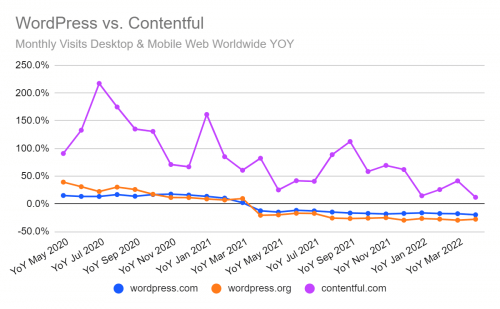WordPress Shrinking After Decade of Steady Growth

For more than a decade, the percentage of all websites that run WordPress has been growing steadily. Now that rocket may be running out of fuel.
Key takeaways
- Our research was prompted by a blog post by Joost de Valk, founder of the WordPress-focused SEO company Yoast that set the WordPress community buzzing by declaring, “There’s no more denying it: if you look at W3Techs CMS market share numbers, WordPress’ market share is shrinking, losing 0.4% market share since February.”
- Is it really happening? The trend is substantiated by Similarweb estimates that in April 2022, visits were down 26.7% for the WordPress.com hosting service and down 25.2% for the WordPress.org open-source resources site. For WordPress.com, year-over-year comparisons have been down consistently since April 2021, by close to 35% some months. Unless otherwise noted, all of these numbers are calculated year over year for desktop and mobile web visits, worldwide.
- If we factor out wordpress.com subdomains (many of which are associated with entry-level myblog.wordpress.com websites rather than the service itself), we still see that visits were down 19.6%, year over year, in April – and have been trending negative since April 2021.
- The reported 0.4% decline in market share is news only because WordPress has grown so consistently for years that the reversal set off alarm bells. Industry blogs like WP Tavern found many web developers losing patience with the platform’s complexity and performance issues.
- Searches on “wordpress” and “wordpress tutorial” (people trying to learn more about the platform) both dropped nearly 20% over the past year, while searches on “wordpress alternatives” rose about 33.5%. There are still many more searches for tutorials, however.
- WordPress competitors like Wix and Squarespace that offer easy-to-use, all-in-one website builders aren’t necessarily gaining at the expense of WordPress in terms of total traffic and attention. Visits to wix.com were down 26.7%, year over year, in April and traffic to Squarespace was down about 9.3%. Hubspot has been gaining, with visits to hubspot.com up 9.2% in April, and the big percentage gainer was Contentful, with visits to contentful.com up 18.2% in April and by higher percentages in the previous month.
For years, the case for building a website on WordPress has been based largely on the idea that everyone else was using it – and more all the time – so it must be a good choice. Could that aura of inevitability now be fading?
For perspective, WordPress is still a giant in the world of web content management, with even the negative reports about its market share putting that share at about 43%. The WordPress.com and WordPress.org websites also remain giant traffic magnets.
WordPress market share is a complicated story
Seeing the total picture for WordPress or the company behind it, Automattic, is not easy.
WordPress started out as software by bloggers for bloggers before maturing into a content management system (CMS) used by major digital publications and marketing websites. While the traffic trends to WordPress.org and WordPress.com tell us something about the current level of interest in the software, it’s possible – even common – for businesses to create a WordPress website without ever visiting WordPress.com or WordPress.org. A business can get a preconfigured WordPress website from any of dozens of web hosts or have it set up for them by a web developer, designer, or consultant.
WordPress.com is the software as a service version run by Automattic, the company that employs many but not all of the developers of the open-source software. Known for being a privately held unicorn that seems to be in no hurry to go public, Automattic has acquired other web properties, such as Tumblr, and also owns WooCommerce, the e-commerce platform that runs on top of WordPress.
Automattic also caters to high-end customers with a bundle of services for ensuring the security and performance of their websites with its WordPress VIP service. The wpvip.com domain gets comparatively little traffic, but it’s intended to be a concierge service rather than a mass-market one.
Some of the declines in total WordPress.com traffic could be a factor of Automattic steering new users away from free subdomain websites and toward getting their own business domain – offered free with the purchase of an annual or two-year subscription. Even so, a decline in traffic to the main wordpress.com domain can’t be good news for the company.
Worse, traffic to the main WordPress.com signup page was down 54% year over year in April and has been down as much as 75% in recent months.
WordPress.com is one of the primary ways Automattic makes money off its investments in the core WordPress software, although it does also sell services to users of the open-source version who install the Jetpack plugin. Jetpack allows those who run independent websites to tap into some WordPress.com capabilities as cloud services.
Since some other web builders are also seeing declines, the drop in interest may reflect broader economic trends or fewer organizations setting out to create a website. The Netcraft survey of web servers, which has been running since 1995, says the total number of sites dropped by 5.23 million in May and also saw declines in March and April.
Less patience for learning WordPress?
WordPress gained prominence as a relatively easy way to create a website. The base software was free and open-source, and getting started with WordPress hosting was relatively inexpensive for a small business. From there, they could choose from a variety of themes (designs) and plugins to add functionality, many free or priced to compete with free. Website owners needing something more custom or attractive could tap into an army of developers and designers who knew how to work with WordPress.
Early on, “easy” meant being able to create and edit website content without writing HTML code, since WordPress provided a sort of web-based word processor. Web consultants could train their clients on the self-service potential of the platform and program their customizations in PHP, a relatively easy-to-learn web scripting language.
These days, ease of use claims for WordPress are undercut by website builders like Wix and Squarespace that support customization of entire websites with drag-and-drop tools. For some businesses, that might mean eliminating the need to hire a developer or designer, or reducing the number of hours that developer or designer will have to spend (and bill) to create a website. Meanwhile, at the high end, Hubspot offers a website builder delivered as part of a suite of integrated digital tools including email marketing and landing page management.
WordPress-based website builders like Elementor offer some of the same convenience but at the cost of adding another layer of complexity. Automattic and its open-source partners have tried to respond in a staged, strategic manner with their Project Gutenberg elaborations on the WordPress editor, culminating recently in the introduction of a “full site editing” capability meant to add Wix-like capabilities while maintaining compatibility with the generations of WordPress software that has gone before.
Critics say it’s too little, too late, and that the user experience and performance characteristics of websites running the software aren’t where they need to be. WordPress is also subject to complaints that it has turned into an overly complicated legacy system with layers upon layers of architecture and configuration options.
Meanwhile, the technical skills required of developers working on WordPress have become significantly greater with the need to learn a React-based JavaScript framework for some customizations while still relying on PHP for server-side software development.
Off with the head!
While Wix and Squarespace battle WordPress on ease of use, another front has opened up with developers who want to create high-performance and highly sophisticated websites without the overhead of a monolithic CMS.
This is known as “headless CMS” development. The approach allows front-end web developers and designers to work with clean code, written in the most modern Javascript frameworks, and interact with back end resources like a CMS or a database only through web application programming interfaces (APIs). In some cases, WordPress might still be in the picture as the back-end repository of content. However, there are also new competitors in the market built specifically around this concept.
One that’s been coming on strong for the past couple of years is Contentful, which has seen year-over-year traffic growth rates of as much as 200% – albeit on a small base. Another, Gatsby (gatsbyjs.com) was seeing huge growth in visits in late 2020 and early 2021, although traffic has since tapered off.
Automattic isn’t blind to the headless CMS trend, and in September it acquired Frontity, the developer of a front-end React framework for websites that can be paired with WordPress as the editing and site administration back end. So there’s a possible future in which headless becomes the standard but WordPress is still part of it.
Continued growth no longer looks inevitable
A fraction of a percentage point change in WordPress CMS market share may look trivial, given that WordPress could lose fractions of a point for years and still be more popular than all its rivals. Whether presiding over the growth of WordPress and related products will remain a profitable business for Automattic is a question we can’t answer about a private company, although the fact that they keep acquiring companies and playing it coy about the possibility of going public suggests they’re not suffering much, if at all, at least not yet, from the trends we’ve discussed.
On the other hand, Automattic’s eagerness to add to its product portfolio may reflect a recognition that WordPress alone is not enough to power its future. It needs to capture a bigger fraction of all the money spent on WordPress websites and use products like WooCommerce to woo customers who care about selling online more than the technology behind the scenes.
The Similarweb Insights Newsroom is available to pull additional or updated data on request for the news media (journalists are invited to write to press@similarweb.com). When citing our data, please reference Similarweb as the source and link back to the most relevant blog post or similarweb.com/blog/insights/.
Disclaimer: All data, reports and other materials provided or made available by Similarweb are based on data obtained from third parties, including estimations and extrapolations based on such data. Similarweb shall not be responsible for the accuracy of the materials and shall have no liability for any decision by any third party based in whole or in part on the materials.
Image-based on an illustration by fsweb_de from Pixabay
Wondering what Similarweb can do for your business?
Give it a try or talk to our insights team — don’t worry, it’s free!
